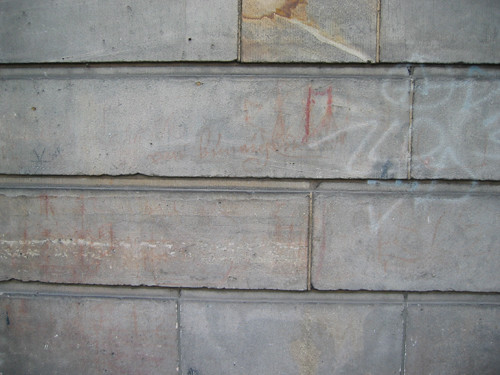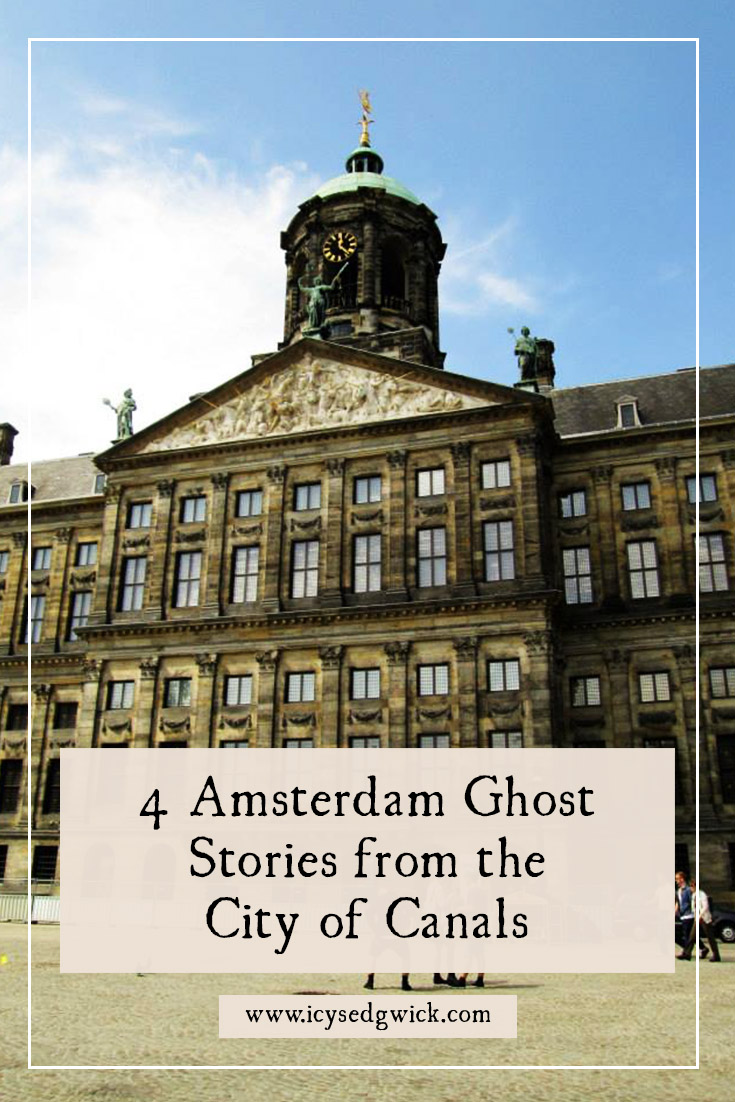Amsterdam is famous for a lot of things, from its picturesque canals to the Anne Frank House, and more besides. What you might not expect from the Dutch capital is a series of Amsterdam ghost stories.
Though why not? The city enjoys some 800 years of history, including wartime occupation, economic boom times, and floods. Of course there would be ghosts and legends!
There is Black Matthew, the 13th-century magician who has been seen all over the city. According to legend, he used his magical abilities to maintain his winning streak when gambling. Unfortunately, he tried to cheat the devil, which never ends will. He’s doomed to wander Amsterdam looking for a new game.
Then there’s the ghostly family at the Montelbaan Tower. The city built the tower in the early 1500s to help defend Amsterdam from attacks. The family appears every year on 2 June, rushing up the tower staircase before they disappear at the top. According to legend, the family was heading for the tower when they were killed. Other versions of the story note the family wear 1900s clothing. There’s also a version of the story in which people only see a young boy.

And there’s Bloedstraat. According to legend, a monastery once stood here, and those executed there for heresy still haunt the street. Others say a so-called ‘Council of Blood’ met at the monastery to decide the fate of criminals. And notorious criminal Janus de Winter’s own gang killed him in the street in the 17th century (Alex 2023). That’s surely got to leave some kind of a psychic imprint on a place.
But enough of the preamble. Let’s explore four Amsterdam ghost stories!
1. The Jealous Sister
The Zeedijk acts as the northern boundary of the red-light district, and in the 18th century, there was a tannery in an alley just off the street. The alley is the site of one of the most famous Amsterdam ghost stories.
The tannery’s owner, a man by the name of Schaap, had two daughters, Helena and Dina. By all accounts, they were both beautiful, but where Dina was laidback and friendly, Helena was passionate and envious.
A handsome sailor named Wouter arrived in the area. Helena got her eye on him, but in typical ghost story fashion, he fell in love with Dina instead. This enraged Helena, who felt that Wouter should be with her. She tried seducing him, which failed. She even tried to steal his letters to Dina so she could persuade her sister that Wouter had lost interest. But again, she failed.

Eventually, Dina found out about the stolen letters. She confronted Helena, and their argument turned physical. Furious that Dina had not only stolen Wouter but was now challenging her, Helena pushed Dina into the cellar. Helena locked the door and left her there.
Two days passed, and Helena went to see what had become of Dina. When she found she was still alive, Helena beat her to death, making the death look like an accident.
Wouter returned and agreed to marry Helena now that his beloved Dina was dead. Surprisingly, Helena managed life as a married woman and little is included in the story about their life together. But for some reason, as she lay dying in 1753, she confessed to the murder. She begged Wouter’s forgiveness, but he refused and cursed her soul never to rest.
While it’s unclear what happened in the years immediately after her death, exactly a century later on July 23, 1853, people heard Helena screaming on the site of the tannery. Plenty of reports see her wandering the alley, miserable and stuck on earth for eternity. A TV crew and onlookers gathered on July 23, 1953, hoping to hear her cries again, but apparently, nothing happened.
No one has been able to find evidence of the tannery.
2. Dam Square
Then there’s Dam Square, now a fine public square and home to the Royal Palace. Except it was once the site of public executions, notably for heretics and witches during the Spanish Inquisition. Some think their ghosts still wander the area, including the corridors of the Royal Palace.
It wouldn’t be a surprise if the Royal Palace was haunted. One of its rooms, the Judiciary, is a particularly forbidding place and a holdover from its time as the town hall. Statues around the space represent remorse, guilt, judgement, and death.
This was the place where the accused faced sentencing. If they were found guilty, they’d be marched straight through the doors, out into Dam Square, for execution. Do the ghosts of those killed in the square still linger?
Though it’s not just the Inquisition that added to Dam Square’s reputation. It was also the site of a mass killing in the 20th century. A crowd of people gathered on 7 May 1945 to celebrate the liberation of Amsterdam. German soldiers fired their machine guns into the crowd, killing over 30 people (Alex 2023). Some think their ghosts remain in the square, still whispering to people as they go about their day.
3. A Doomed Relationship at the Spinhuis
You might spot a building called The Spinhuis, or the Spinning House. Since 2016, the Meertens Institute and the Huygens Institute for Dutch History have occupied it.
But the building itself was part of the St Ursula Monastery, and in 1597, became the home of the Spinhuis. Its goal was simple: take “troubled” women and put them back on the straight and narrow. To do this, they forced the women, who were often poor and sex workers, to do sewing and spinning work. The aim wasn’t necessarily all that noble since the Spinhuis provided cheap labour – and the workers held there didn’t get to enjoy the fruits of that labour.
According to legend, parents would take their children to the Spinhuis on Sundays so they could see what would become of them if they didn’t listen to their parents.
The original Spinhuis burned down in 1643, and the authorities built a new building on the same site in 1645. That’s the facade you can see now. The relief over the door shows women at work.

But we’re here for ghosts, and there’s one particularly famous story about the place. Priests lived in the building opposite the Spinhuis, which is now a hotel. A priest fell in love with one of the young women forced to work there, though some sources stress that she was a young girl. Eventually, their relationship was discovered. The church protected him, but they condemned her to live out her days at the Spinhuis.
Devastated by the turn of events, the priest finally took his own life in his room overlooking the Spinhuis. According to the legend, he repeats this act every night since he’s doomed for both breaking his vows and taking his own life. Guests have complained of being awoken by a strange noise every night at the same time, so perhaps the priest really is reliving his final moments forever.
4. The Blood House
Our final story isn’t exactly a ghost story – but it’s a weird tale nonetheless. An otherwise unremarkable house overlooks the Amstel River, at 216 Amstel. The building dates to the early 1670s for a soap manufacturer.
But nowadays, it’s known as the Blood House.

A man named Coenraad van Beuningen is responsible for its reputation. He was both the mayor of Amsterdam and an ambassador. Being very successful, he finally took the house at 216 Amstel.
After he moved in, the otherwise successful and outgoing man seemed to completely change – although the loss of his fortune might have contributed to that. According to Antoine Borg, by 1689 he’d gone insane, reporting visions of floating coffins over Amsterdam and fireballs raining from the sky (2018).
Van Beuningen started painting occult symbols all over the outside of the house. Some say he used his blood, hence the name for the house. You can still see many of them from the outside, though naturally, they’ve faded over time.
It’s now a private residence so who knows if van Beuningen’s spirit continues to roam the rooms inside?
What do we make of these Amsterdam ghost stories?
One theory claims Amsterdam is so haunted thanks to the canals, since water is conducive to ghosts. A study from 1960 by G.W. Lambert, The Geography of London Ghosts, claimed that around 75% of the paranormal activity in London happens near buried waters (Ackroyd 2012: 49). Whether this is thanks to subterranean water spirits or the strange properties of sound created by a buried steam remains to be seen. Who knows if the same applies in Amsterdam?
Or perhaps the weight of so much history is bound to leave an imprint on the city. As with the other stories in this European City ghost story theme, having lots of people living alongside each other on the same site for centuries will create all sorts of energetic signatures.
What’s your favourite of these Amsterdam ghost stories? Let me know!
References
Ackroyd, Peter (2012), London Under, London: Vintage (affiliate link).
Alex (2023), ’16 Most Haunted Places in Amsterdam’, Spooky Traveler, https://spookytraveler.com/haunted-places-in-amsterdam/.
Borg, Antoine P (2018), ‘The strange case of Amsterdam’s House of the Blood Stains’, The Unexpected Traveller, http://www.unexpectedtraveller.com/house-of-blood-stains/.
Huetter, Alexandra (2022), ‘5 of the most haunted places in Amsterdam’, Dutch Review, https://dutchreview.com/culture/history/5-haunted-places-amsterdam/.
I amsterdam (2023), ‘Haunted places in Amsterdam for Halloween lovers’, I amsterdam, https://www.iamsterdam.com/en/see-and-do/attractions-and-sights/haunted-places-in-amsterdam.
PocketSights (no date), ‘Het Spinhuis’, PocketSights, https://pocketsights.com/tours/place/Het-Spinhuis-39381:4677.
PocketSights (no date), ‘Spooksteeg Alley’, PocketSights, https://pocketsights.com/tours/place/Spooksteeg-Alley-39373:4677.
Nutty about folklore and want more?
Add your email below and get these posts in your inbox every week.
You'll also get my 5-step guide to protecting your home using folklore!









Have your say!